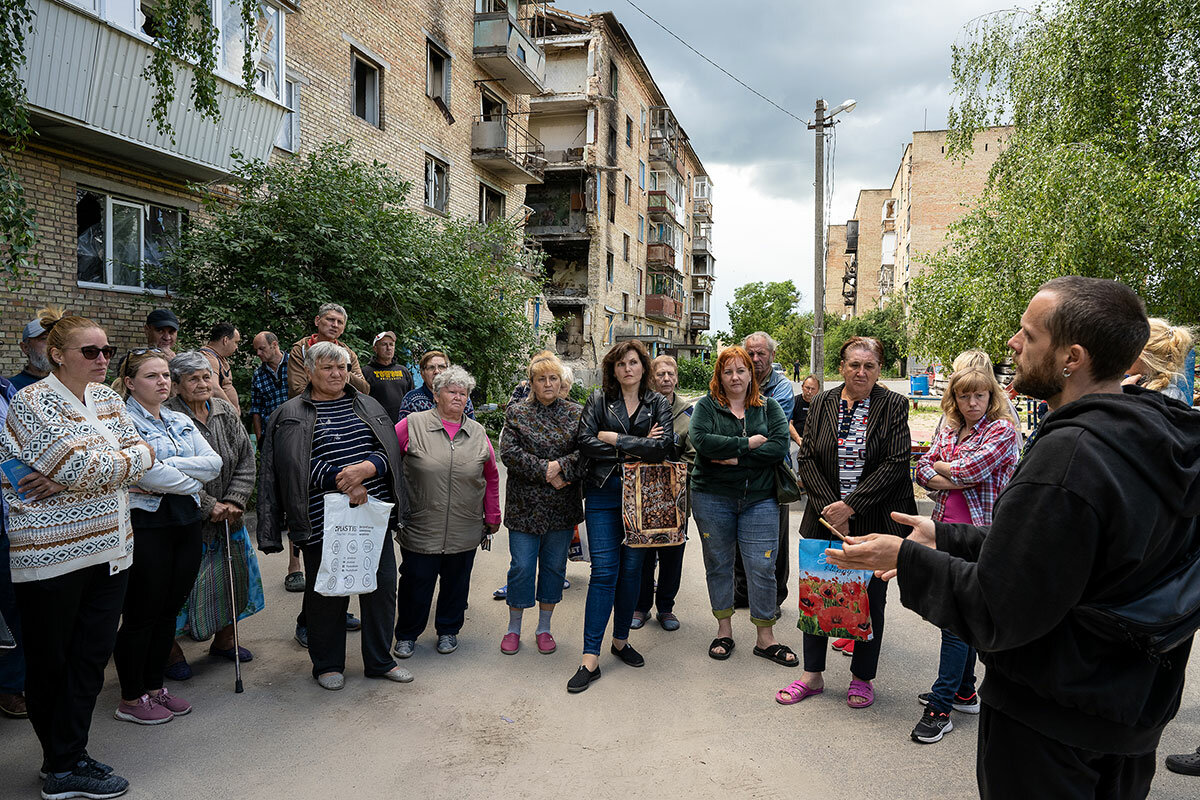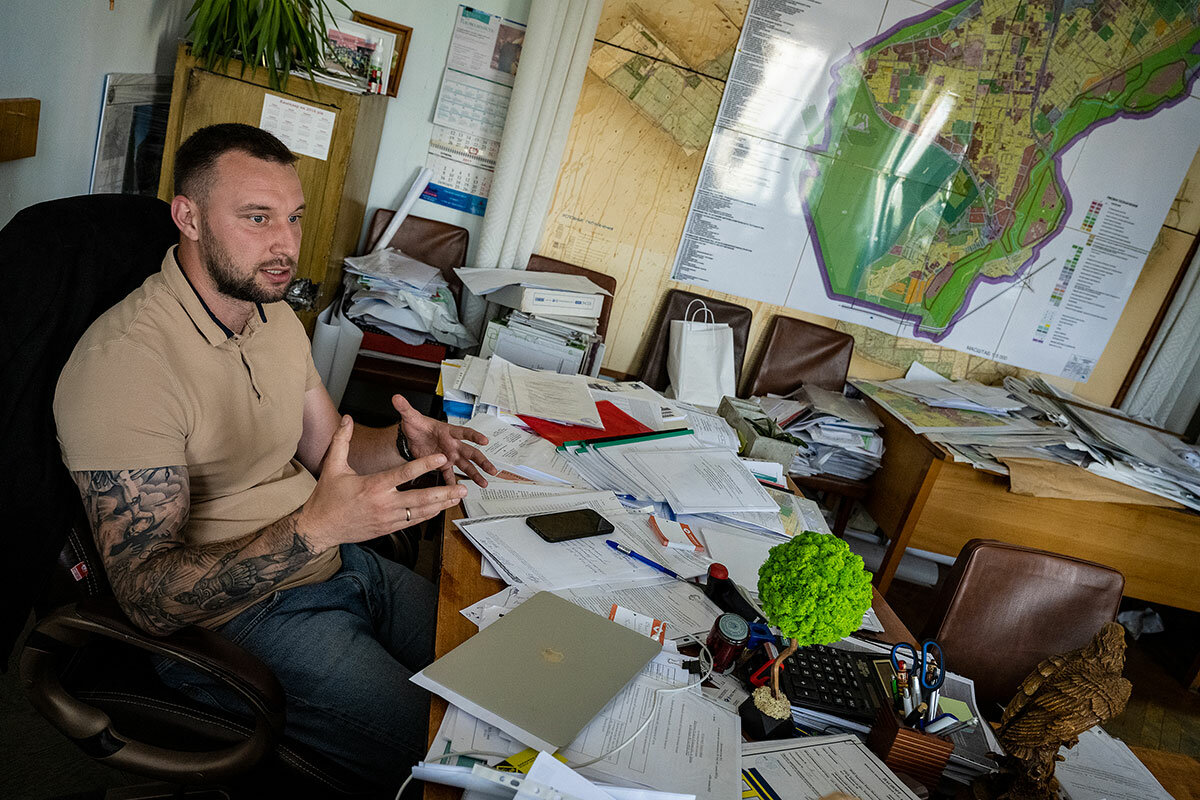Can – and should – Ukraine rebuild while the war still rages?
| HORENKA and IRPIN, UKRAINE
In her fourth-floor apartment, down a dark, tight hallway, Olena Kolinovych walks into the room she no longer uses.
It’s piled with mementos – a model John Deere tractor on a shelf, a Chinese fan on the wall. She takes a jacket from a hanger and points to a tear, showing white synthetic down. Shrapnel did that, she says.
On the far end of the room there’s a broken wall exposing a broken balcony. Both were damaged by Russian artillery in March, when Horenka, this small town north of Kyiv, was on the front lines. Almost all of its buildings need to be repaired, or entirely rebuilt.
Why We Wrote This
A story focused onSome Ukrainians feel that it’s time to begin to rebuild their homes. But with the Russian invasion still endangering those homes – as well as their residents – rebuilding now requires a special resilience.
Ms. Kolinovych hopes hers will be soon. She and her husband fled March 4 for the southwestern city of Vinnytsia and returned in mid-May. For weeks, they’ve lived without running water, electricity, or gas. They’ve compartmentalized their damaged items into the damaged room. Now, they live on the other side of the small apartment, stay cheerful, and wait for help.
“We hope that someone will help us and they will fix our house,” she says. “We don’t want to leave this place.”
The war in Ukraine has destroyed more than $100 billion in public and private infrastructure, according to the Kyiv School of Economics. And in the eastern Donbas region, where Russia refocused its invasion, that devastation is still ongoing. In places like Horenka, though, the new front lines are hundreds of miles away, and people are starting to rebuild.
Creating a blueprint for the process has become a national dilemma. Atop the wreckage, the government in Kyiv will inevitably want to design and build a 21st-century Ukraine. But leading a project of that scale takes time and resources – both scarce during war. And right now, people need shelter, infrastructure, and work.
Ukrainians have already shown they can survive a brutal, senseless war. Recovering from it will demand a different kind of resilience – not to endure loss, but to effectively heal from it. But Ukraine must fight its war and rebuild from it at the same time.
“People are already returning,” says Emily Channell-Justice, director of the Temerty Contemporary Ukraine Program at Harvard University’s Ukrainian Research Institute. “They’re going to rebuild anyway. So why not be more systematic and think of it as a contribution to the war effort?”
“What do we have to do now?”
Early in the afternoon on June 22, Ms. Kolinovych joins a small crowd at the apartment building across from hers. District 1, a nongovernmental organization dedicated to rebuilding Kyiv, is trying to renovate both buildings and is hosting a town hall with the remaining residents.
Wearing a black hoodie and sweatpants that read “no problemo,” District 1 co-founder Andrii Titarenko tells the crowd what it’ll take to fix their homes, outlining a near civics lesson on bureaucracy. The group plans to provide a tent with water tanks, generators, a portable shower, and other utilities.
But District 1 can’t work on the buildings until an official inspector assesses the damage. Its volunteers will lobby the local government, says Mr. Titarenko, but it’s already afraid its contact will stop picking up the phone. So everyone should prepare for a long wait.
Kids play in the background, as members of the crowd joke about the red tape. Next to them, the middle of the apartment building is missing a 30-foot, five-story section – leveled in March by a Russian bomb. Cabinets and cucumber preserves hang on kitchen walls left without a kitchen floor.
Mr. Titarenko waits for questions. “What do we have to do now?” a resident asks.
Give interviews and think of ways to get donor attention, Mr. Titarenko tells them. “For the government it’s like one of the hundreds – thousands – of buildings around Ukraine.” Even if it weren’t, Kyiv is fighting other battles. “They are now concentrated on the war,” he says.
Fight or rebuild?
At this stage, focusing almost only on the war may be the right strategy, says Charles Lichfield, deputy director of the Atlantic Council’s GeoEconomics Center. It doesn’t make sense for the government to waste resources rebuilding parts of the country the Russians may yet attack.
According to estimates from the Kyiv School of Economics, the war has destroyed some $104 billion in fixed assets – including roads, airports, houses, and rails. Around 861,000 families have lost their homes. More than 3.5 million Ukrainians are without permanent housing altogether.
“I’m not so optimistic as other people who believe that we should rebuild Ukraine as fast as we can,” Minister of Finance Sergii Marchenko said during an Atlantic Council event in late May. “I am very pessimistic in this endeavor, because we should win this war first and then we can start that process.”
Waiting to start has its advantages. It would allow more time for the government to improve infrastructure and urban planning, and even tie the funds to corruption and judicial reforms.
But delays have costs, too, as the residents in Horenka make clear.
When Ms. Kolinovych and her husband returned on May 14, they found an improvised camp set up like an outdoor living room. Two black kettles sit next to a fire pit and a propped-up watercooler. Under the nearby tree, there’s a kitchen table with mismatched chairs. She’s been cooking there ever since.
Others don’t have that option. Tetania, who didn’t give her last name, attended the short town hall while her two young boys, Sasha and Dima, played nearby. For 12 years, Tetania lived down the hall from Ms. Kolinovych. This March, Russian missiles completely destroyed her apartment. She, her husband, and her two boys have since moved to a one-bedroom apartment in neighboring Hostomel.
Her children – one of them wearing a Lightning McQueen hat from Pixar’s “Cars” – make engine noises while “driving” rubble down fallen fence posts. Tetania looks up at the black walls that used to be her home, and starts to cry. What hurts most, she says, is that the photo albums of her boys were burned in the fire. She hopes one day to again live where those memories were made.
“I understand that it might not be quick, but in principle I would like to stay here,” says Tetania. “I love this place.”
The future of Irpin
In the wealthy suburb of Irpin, just miles away, it’s Mykhailo Sapon’s job to help people like her get their homes back. Mr. Sapon is the city’s chief architect, and his office is a litter of maps and photographs, strewn across walls and tables. For a city in disrepair, it’s fitting.
In the five years before the war, Irpin had thrived. Among other projects, it added a stadium, a school, six parks, 50 playgrounds, and five kindergartens. Then came the invasion, and 40% of the city was under occupation. In the end, 70% of Irpin was destroyed and 3,000 homes were damaged – half of them beyond repair.
Windows are now broken, bark is torn from trees, and buildings are charred. The municipal center, where Mr. Sapon works, is one of the only places that looks untouched. He wasn’t. During the occupation, Mr. Sapon barely survived a Russian bullet while leaving his house, 12 miles north of the city, for medical supplies.
Mr. Sapon and his office, working 10 hours a day, six days a week, are trying to solve a child care problem, a housing problem, and an employment problem all at once. Their master plan for Irpin’s future will take months. But for some problems, like schools, they can’t wait that long.
“We have to in some ways to rebuild and to reconstruct it in the shortest way,” says Mr. Sapon. Irpin’s residents, he says, “are waiting [for the city] to do something to make their life better.”
The call of home
Ms. Kolinovych, too, is waiting.
Back in March, she and her family sheltered in a garage close to the apartment building for eight days. They were panicked, she says, crying out of fear and praying for safety. She and her husband left only after their children and grandchildren did, when the bombing became too intense and they could hear helicopters flying above.
They fled in a friend’s car and stayed for 70 days in Vinnytsia, southwest of Kyiv. “Everything was fine there,” she says. “But I really wanted to go back home.”
No home is worth a life, but her life felt incomplete without her home.
Walking past the campfire that’s become her kitchen, up the concrete stairs with broken glass and bullet holes, and into her damaged apartment, Ms. Kolinovych smiles. She’s happy she came back.
Even if her apartment isn’t fixed by the winter, she’s not leaving. Her friends are here. Her community is here. Just being back, she says, is like an answered prayer.
“This is the place where we were born, spent our lives, and our children were born,” says Ms. Kolinovych of her apartment. “It’s just like our motherland.”
Oleksandr Naselenko supported reporting for this story.










